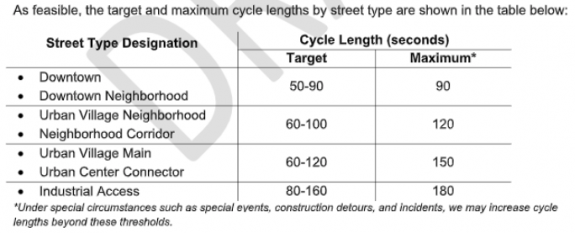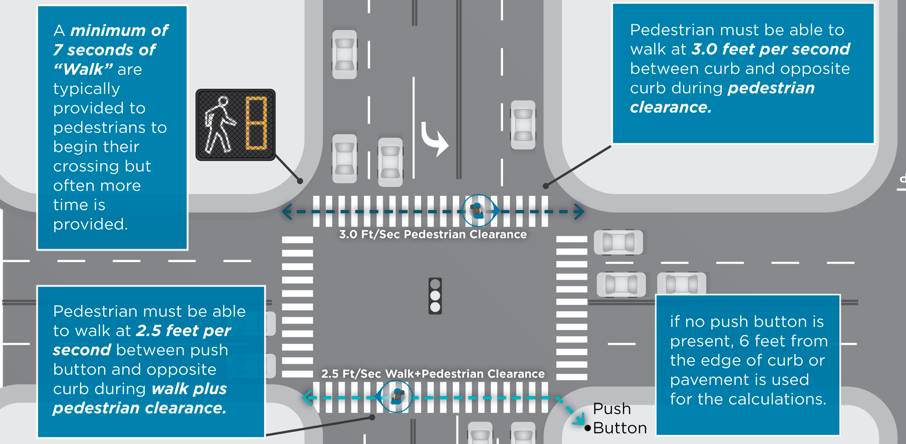The Seattle Department of Transportation has finalized a traffic signals policy intended primarily to improve mobility for people walking and rolling at intersections. This policy comes out of a process that the agency convened with a group called the Policy and Operations Advisory Group, which consists of members of the different modal advisory boards, the transportation equity workgroup, the pedestrian access advisory committee and a few other groups with a stake in SDOT policy.
The policy update includes some benefits that will be seen citywide, but the policy falls short of the promise of revamping signal timing with the goal of moving people over vehicles. A major shortcoming is in the proposed signal lengths, aka the amount of time for a traffic signal to complete a full cycle if you just missed it. Within the middle of Seattle’s densest neighborhoods, a single length of two minutes would be standardized, with a length of even two and a half minutes permitted.
Cycle lengths would be lowest at intersections along streets downtown, with a target of 50-90 seconds, but a maximum signal length of a minute and a half is still very high for the highest volume streets for pedestrians. Urban village neighborhood streets and neighborhood corridors, which include streets like Broadway in the heart of Capitol Hill (which coincidentally has the highest pedestrian volumes of any street in Seattle in recent years), would be able to have longer signal lengths than in downtown. Streets with an urban village main or urban center connector designation (like Rainier Ave S or College Way N) would be able to have longer cycle lengths still. Industrial access streets like 15th Ave W able to have the longest cycle lengths, up to three minutes.

You can use the chart above to match street type designations with this this interactive map to see what the cycle lengths could be on any specific street.
One factor influencing these proposed cycle lengths is a big change that SDOT is proposing to make all every single intersection in Seattle: reducing the standard pedestrian speed used to calculate how much time is provided to cross from 3.5 feet per second to 3 feet per second. The policy will also include a secondary calculation to ensure that someone standing six feet back from the intersection would be able to cross the street using a speed of 2.5 feet per second and use this to adjust total time provided to cross. This should provide more time to cross most intersections that get revised under the policy.

SDOT says that implementing this policy “should reduce wait times and provide more frequent opportunities for pedestrians to cross the street”, while having the effect of “slight increase in delay and travel time” for transit and freight traffic.
But the proposed cycle lengths for urban villages and centers exceed the range noted as ideal by the National Association of City Transportation Officials (NACTO), which says “longer signal cycles and corridor-based timing schemes make large avenues into barriers that separate neighborhoods rather than joining them”. NACTO notes that 60-90 seconds is ideal for urban areas. SDOT should reassess whether intersections outside downtown in most cases need to have a targeted signal length of more than a minute and a half, and at a minimum bring down the very high max cycle length.
Seattle Neighborhood Greenways has set up an action alert on the proposed signal policy’s shortcomings, which you can use to contact SDOT directly here.












Comments
13 responses to “Proposed Signal Policy Could Mean More Long Waits At Intersections”
One note – longer [walk+pedestrian clearance] time does mean *most* pedestrians are slightly less likely to need to wait for the signal to begin with.
Slow pedestrians need to start during the walk phase in order to make it across at 2.5-3 fps.
While technically illegal, faster pedestrians can start crossing half-way through the longer clearance phase and still make it across at a brisk 6-8 fps walk or jog. Longer wait times definitely encourage this behavior.
So you want pedestrians to have to scoot across wide intersections just so cars and bikes don’t have to wait an additional 30 seconds or so? Sounds pretty selfish to me. The reality I see is that bikes act like cars when it suits them and then magically become pedestrians when faced with a red light. This crowds actual pedestrians out of a crosswalk that bikes then take for themselves.
Hi Chris, you sound aggrieved. As a pedestrian you find signal times too short?
I commute from northeast to west seattle on a bike and I have never seen a cyclist crowd a pedestrian out of a crosswalk. But you are right, as a cyclist I do roll stop signs and sometimes even red lights. The reason is that, even if a bike lane exists where I am, there is a pretty good chance that it is blocked by a ride share or delivery driver. Bike lanes also have a nasty habit of inexplicably disappearing when you need them most. It would be like having to merge with freight trains at speed if you are driving a car. SDOT would never let that happen to the driver of a vehicle but they are pretty okay with cyclists and pedestrians doing it. So if I need to make a left hand turn, I just might get the jump on the traffic light so that it isnt a suicidal maneuver. Keep in mind that I wont do this if there is a car coming that has the right of way. I do want to live after all. Rest assured though that several vehicles will pull out directly in front of me when I have the right of way, every day. Remember what a vehicle weighs compared to my bike, and tell me which one is more dangerous.
One upside to this pandemic is that people and businesses have been able to reclaim more of their fair share of the road with less vehicle traffic. More people can see for themselves that urban areas are so much more livable when they are not designed exclusively for cars.
“So you want pedestrians to have to scoot across wide intersections just so cars and bikes don’t have to wait an additional 30 seconds or so?”
Say what? That isn’t at all what the author is proposing. I think you are confused. For example, consider Aurora and 92nd. Aurora is a major street, with lots of cars. 92nd is the opposite — very few vehicles. Now consider this timing combinations:
North-South — 3 minutes
East-West — 30 seconds
There is plenty of time to cross Aurora. On the other hand, if you just miss the light, you have to wait 3 minutes. That is the issue. It isn’t the amount of time to cross. The author has no problem with the 30 seconds to cross, he has a problem with the 3 minutes given over to Aurora drivers before people can cross again.
Or, to put it another (far simpler) way, he is concerned about maximum wait times, not minimum.
I had to make this little chart as I was struggling visualizing those walking speeds. Thought it might be good to share:
FPS MPH min/mile km/h
——————————————–
2.5 1.7 35:12 2.7
3 2.0 29:20 3.3
3.5 2.4 25:09 3.8
6 4.1 14:40 6.6
9 6.1 09:47 9.9
12 8.2 07:20 13.2
15 10.2 05:52 16.5
——————————————–
Infuriating. Even 90 seconds is a long time to wait.
I have written the following suggestion to SDOT but I’ll repeat it here.
One possible improvement would be to change the purpose of the walk-request button. The new purpose would be to lengthen the amount of walk time.
In other words, nearly all intersections would provide a walk light automatically but the duration would be short – just long enough for someone to walk across briskly. But, if you need extra time, you press the walk button.
Doing something like this would allow minor crossing streets to have shorter green lights as long as no “slow” peds are present. Consequently, the overall cycle time could be reduced, allowing more traffic to get through on the main street, even without lengthening the green time for the main street.
This might not apply to all intersections but certainly could help in areas or times where there are light pedestrian crossings.
Is this a workable solution. Is it legal ?
i love this idea!
Another thing that could help is eliminate left turns where there are alternatives.
A left turn adds to the cycle length. If you don’t have them, you can reduce the max wait for peds.
A example where I particularly think this could help is along Mercer St between the freeway and Aurora. In the old days, left turns were necessary because Mercer was one of the few places you could cross Aurora. But today, you can take several other streets. Allow the left turns on those streets and eliminate them on Mercer.
I agree, there should be fewer left turns allowed. Most of the time, you should just take three rights.
I wish the city would explore pedestrian/bicycle scrambles at major intersections. To me holding all vehicle movements during the pedestrian phase seems like the safety way for active transportation to move through an intersection. I haven’t modeled it but do wonder if you coordinate signals and provide a series of scrambles you might improve overall system efficiency.
Another solution that should be considered is adding pedestrian islands so that people can cross halfway. This allows the cycles to be shortened while still allowing slower walkers to safely cross the street. You can even program the signals to allow half crossings during the left turn phases (the half that doesn’t conflict with car movement).
Also useful thing would be more per crossing points at minor intersections that don’t have all that turning car traffic like the major intersections do. A minor intersection also allows for a pedestrian island to replace left turn lanes – another plus.